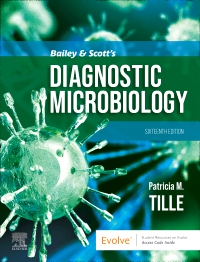PART I: BASIC MEDICAL MICROBIOLOGY
1. Microbial Taxonomy
2. Bacterial Genetics, Metabolism, and Structure
3. Host-Microorganism Interactions
PART II: GENERAL PRINCIPLES IN CLINICAL MICROBIOLOGY
Section 1: Safety and Specimen Management
4. Laboratory Safety
5. Specimen Management
Section 2: Approaches to Diagnosis of Infectious Diseases
6. Role of Microscopy
7. Conventional Cultivation and Identification
8. Nucleic Acid-Based Analytic Methods for Microbial Identification and Characterization
9. Overview of Immunochemical Methods Used for Organism Detection
Section 3: Evaluation of Antimicrobial Activity
10. Principles of Antimicrobial Action and Resistance
11. Laboratory Methods and Strategies for Antimicrobial Susceptibility Testing
PART III: BACTERIOLOGY
Section 1: Principles of Identification
12. Overview of Bacterial Identification Methods and Strategies
Section 2: Catalase-Positive, Gram-Positive Cocci
13. Staphylococcus, Micrococcus, and Similar Organisms
Section 3: Catalase-Negative, Gram-Positive Cocci
14. Streptococcus, Enterococcus, and Similar Organisms
Section 4: Non-Branching, Catalase-Positive, Gram-Positive Bacilli
15. Bacillus and Similar Organisms
16. Listeria, Corynebacterium, and Similar Organisms
Section 5: Non-Branching, Catalase-Negative, Gram-Positive Bacilli
17. Erysipelothirix, Lactobacillus, and Similar Organisms
Section 6: Branching or Partially Acid-Fast, Gram-Positive Bacilli
18. Nocardia, Streptomyces, Rhodococcus, and Similar Organisms
Section 7: Gram-Negative Bacilli and Coccobacilli (MacConkey-Positive, Oxidase-Negative)
19. Enterobacterales
20. Acinetobacter, Stenotrophomonas, and Other Organisms
Section 8: Gram-Negative Bacilli and Coccobacilli (MacConkey-Positive, Oxidase-Positive)
21. Pseudomonas, Burkholderia, and Similar Organisms
22. Achromobacter, Rhizobium, Ochrobactrum, and Similar Organisms
23. Chryseobacterium, Sphingobacterium, and Similar Organisms
24. Alcaligenes, Comamonas, and Similar Organisms
25. Vibrio, Aeromonas, Plesiomonas shigelloides, and Chromobacterium violaceum
Section 9: Gram-Negative Bacilli and Coccobacilli (MacConkey-Negative, Oxidase-Positive)
26. Sphingomonas paucimobilis and Similar Organisms
27. Moraxella
28. Eikenella corrodens and Similar Organisms
29. Pasteurella and Similar Organisms
30. Actinobacillus, Kingella, Cardiobacterium, Capnocytophaga, and Similar Organisms
Section 10: Gram-Negative Bacilli and Coccobacilli (MacConkey-Negative, Oxidase-Variable)
31. Haemophilus
Section 11: Gram-Negative Bacilli that are Optimally Recovered on Special Media
32. Bartonella
33. Campylobacter, Arcobacter, and Helicobacter
34. Legionella
35. Brucella
36. Bordetella pertussis and Bordetella parapertussis,
37. Francisella
38. Streptobacillus moniliformis and Similar Organisms
Section 12: Gram-Negative Cocci
39. Neisseria and Moraxella catarrhalis
Section 13: Anaerobic Bacteriology
40. Overview and General Laboratory Considerations
41. Overview of Anaerobic Organisms
Section 14: Mycobacteria and Other Bacteria with Unusual Growth Requirements
42. Mycobacteria
43. Obligate Intracellular and Nonculturable Bacterial Agents
44. Cell Wall-Deficient Bacteria: Mycoplasma and Ureaplasma
45. The Spirochetes
PART IV: PARASITOLOGY
46. Overview of the Methods and Strategies in Parasitology
47. Intestinal Protozoa
48. Blood and Tissue Protozoa
49. Protozoa from Other Body Sites
50. Intestinal Nematodes
51. Tissue Nematodes
52. Blood Nematodes
53. Intestinal Cestodes
54. Tissue Cestodes
55. Intestinal Trematodes
56. Liver and Lung Trematodes
57. Blood Trematodes
PART V: MYCOLOGY
58. Overview of Fungal Identification Methods and Strategies
59. Hyaline Molds, Zygomycetes, Dermatophytes, and Opportunistic and Systemic Mycoses
60. Dematiaceious Molds
61. Pneumocystis jirovecci, Lagenidium, Paralegenidium, Pythium, Rhinosporidium and Uncultivated Paracocidioides
62. The Yeasts
63. Antifungal Susceptibility Testing, Therapy, and Prevention
PART VI: VIROLOGY
64. Overview of the Methods and Strategies in Virology
65. Viruses and Prions in Human Disease
66. Antiviral Therapy, Susceptibility Testing, and Prevention
PART VII: DIAGNOSIS BY ORGAN SYSTEM
67. Bloodstream Infections
68. Infections of the Lower Respiratory Tract
69. Upper Respiratory Tract Infections and Other Infections of the Oral Cavity and Neck
70. Meningitis and Other Infections of the Central Nervous System
71. Infections of the Eyes, Ears, and Sinuses
72. Infections of the Urinary Tract
73. Genital Tract Infections
74. Gastrointestinal Tract Infections
75. Skin, Soft Tissue, and Wound Infections
76. Normally Sterile Body Fluids, Bone and Bone Marrow, and Solid Tissues
PART VIII: CLINICAL LABORATORY MANAGEMENT
77. Quality in the Clinical Microbiology Laboratory
78. Infection Prevention
79. Sentinel Laboratory Response to Bioterrorism
Glossary
Index
Patricia M. Tille, PhD, MLS(ASCP), AHI(AMT), FACSc, Department Vice Chair, Clinical and Health Information Sciences, Graduate Program Director/Professor, Medical Laboratory Science, University of Cincinnati, Cincinnati, Ohio; Chair, Microbiology Advisory Committee, International Federation of Biomedical Laboratory Science; Editor in Chief, International Journal of Biomedical Laboratory Science, International Federation of Biomedical Laboratory Science; President, American Society of Clinical Laboratory Science, USA





 as described in our
as described in our 